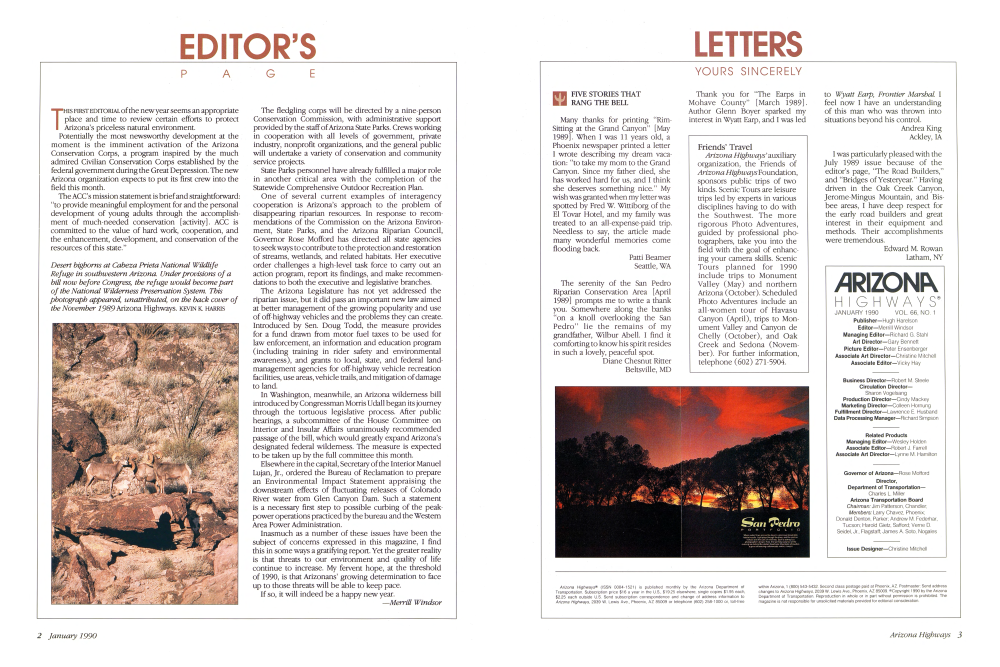Editor's Page

THIS FIRST EDITORIAL of the new year seems an appropriate place and time to review certain efforts to protect Arizona's priceless natural environment.
Potentially the most newsworthy development at the moment is the imminent activation of the Arizona Conservation Corps, a program inspired by the much admired Civilian Conservation Corps established by the federal government during the Great Depression. The new Arizona organization expects to put its first crew into the field this month.
The ACC's mission statement is brief and straightforward: “to provide meaningful employment for and the personal development of young adults through the accomplishment of much-needed conservation [activity]. ACC is committed to the value of hard work, cooperation, and the enhancement, development, and conservation of the resources of this state.” Desert bighorns at Cabeza Prieta National Wildlife Refuge in southwestern Arizona. Under provisions of a bill now before Congress, the refuge would become part of the National Wilderness Preservation System. This photograph appeared, unattributed, on the back cover of the November 1989 Arizona Highways. KEVIN K. HARRIS The fledgling corps will be directed by a nine-person Conservation Commission, with administrative support provided by the staff of Arizona State Parks. Crews working in cooperation with all levels of government, private industry, nonprofit organizations, and the general public will undertake a variety of conservation and community service projects.
State Parks personnel have already fulfilled a major role in another critical area with the completion of the Statewide Comprehensive Outdoor Recreation Plan.
One of several current examples of interagency cooperation is Arizona's approach to the problem of disappearing riparian resources. In response to recommendations of the Commission on the Arizona Environment, State Parks, and the Arizona Riparian Council, Governor Rose Mofford has directed all state agencies to seek ways to contribute to the protection and restoration of streams, wetlands, and related habitats. Her executive order challenges a high-level task force to carry out an action program, report its findings, and make recommendations to both the executive and legislative branches.
The Arizona Legislature has not yet addressed the riparian issue, but it did pass an important new law aimed at better management of the growing popularity and use of off-highway vehicles and the problems they can create. Introduced by Sen. Doug Todd, the measure provides for a fund drawn from motor fuel taxes to be used for law enforcement, an information and education program (including training in rider safety and environmental awareness), and grants to local, state, and federal land management agencies for off-highway vehicle recreation facilities, use areas, vehicle trails, and mitigation of damage to land.
In Washington, meanwhile, an Arizona wilderness bill introduced by Congressman Morris Udall began its journey through the tortuous legislative process. After public hearings, a subcommittee of the House Committee on Interior and Insular Affairs unanimously recommended passage of the bill, which would greatly expand Arizona's designated federal wilderness. The measure is expected to be taken up by the full committee this month.
Elsewhere in the capital, Secretary of the Interior Manuel Lujan, Jr., ordered the Bureau of Reclamation to prepare an Environmental Impact Statement appraising the downstream effects of fluctuating releases of Colorado River water from Glen Canyon Dam. Such a statement is a necessary first step to possible curbing of the peak power operations practiced by the bureau and the Western Area Power Administration.
Inasmuch as a number of these issues have been the subject of concerns expressed in this magazine, I find this in some ways a gratifying report. Yet the greater reality is that threats to our environment and quality of life continue to increase. My fervent hope, at the threshold of 1990, is that Arizonans' growing determination to face up to those threats will be able to keep pace.
If so, it will indeed be a happy new year.
Already a member? Login ».